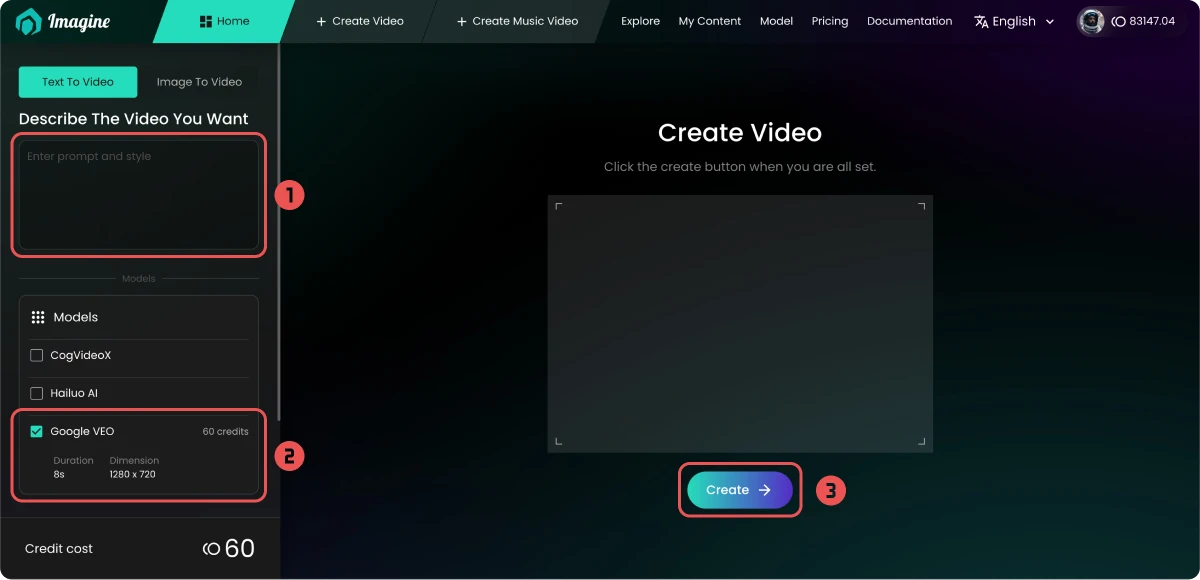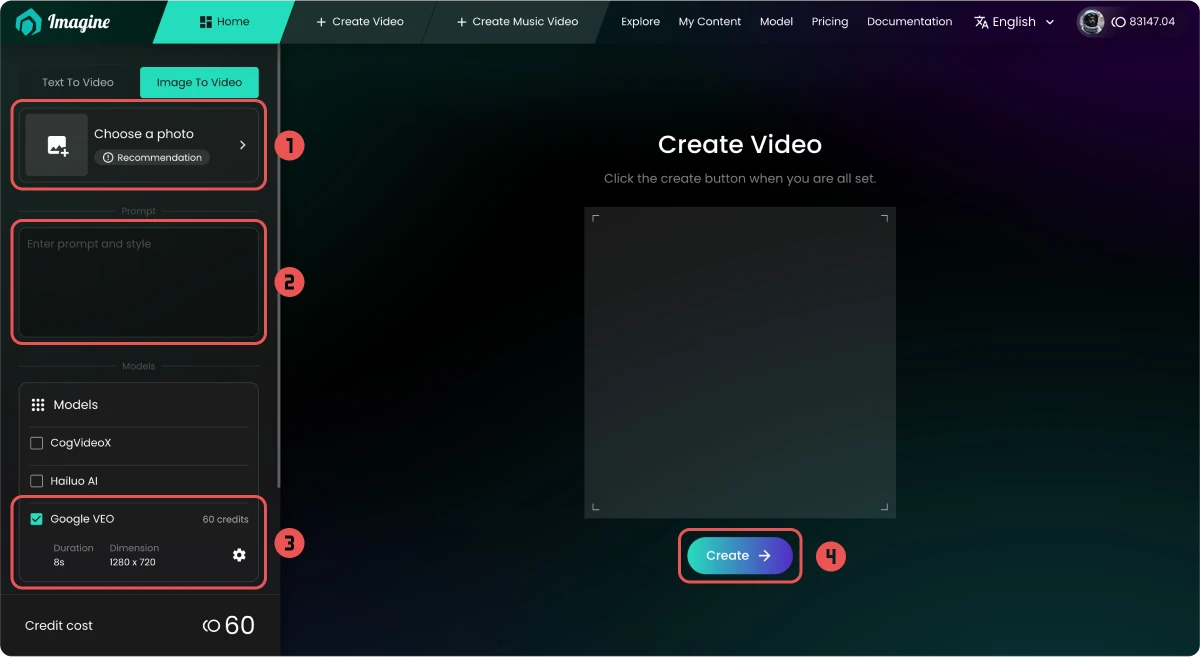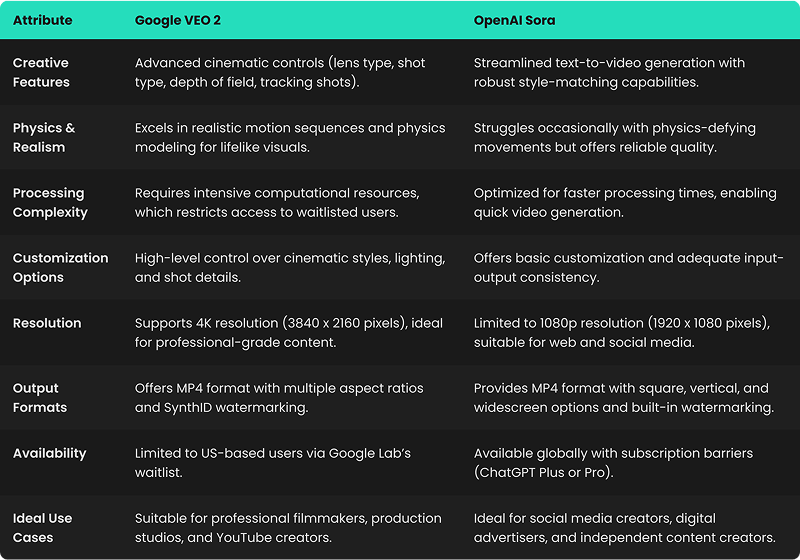What is Google VEO 2?
Google VEO 2 is Google’s latest AI-powered video generation model, designed to create ultra-realistic videos from text and images with advanced motion consistency, scene coherence, and extended duration. As the successor to VEO 1, it brings groundbreaking improvements in AI-driven video creation, making it a top choice for filmmakers, content creators, and AI enthusiasts. With Google VEO 2, users can generate:
- Realistic videos: Generates highly detailed videos with fewer errors than its predecessor, delivering lifelike visuals that closely mimic real-world environments.
- Advanced control: Users can fine-tune their videos with precise customization, selecting lens types, camera angles, and special effects to enhance the cinematic feel.
- High resolution: Supports video generation at up to 4K resolution, though the current early access phase is limited to 720p output.
- Smooth motion: Leverages advanced real-world physics modeling to ensure fluid, natural movement in dynamic scenes, enhancing realism and believability.
- Versatility: Adapts to both simple and complex prompts, seamlessly integrating different artistic styles and real-world physics to generate cinematic-quality videos with stunning high-definition visuals and fluid transitions.
Many are asking, "When will Google VEO 2 be available?" or "When is VEO 2 coming out?". While Google has not yet announced a public release date, early access is already available through Imagineapp, making it one of the first platforms offering access to this cutting-edge technology.
How to Get Access to Google VEO 2?
Currently, Google VEO 2 API early access is limited to select partners and companies, with Imagineapp being one of the first platforms to provide public access.
Steps to Apply for Google VEO 2 Early Access:
- 1.Register on Imagineapp - Create a free account at https://imagineapp.co.
- 2.Fill out the early access request form - Submit your details through this form.
- 3.Wait for approval - Once approved, you'll receive free credits and be whitelisted to use VEO 2.
By signing up through Imagineapp, users gain priority access to test Google VEO 2 and generate AI-powered videos before the wider public release.
How to Use Google VEO 2?
Once granted access, you can start using Google VEO 2 directly on Imagineapp at https://imagineapp.co/video. The platform provides a user-friendly interface with two primary modes for AI video generation:
1. Text-to-Video AI
- 1.Input a text prompt: Describe the scene or action you envision.
- 2.Select model: Choose Google VEO 2 as the preferred model for video generation.
- 3.Generate video: Click the "Create" button to initiate the video generation process.

2. Image-to-Video AI
- 1.Upload a static image: Jump to the “Image To Video” tab and provide an image to serve as the video's foundation.
- 2.Input a text prompt: Provide a detailed description of the scene or action you want to create.
- 3.Select model: Choose Google VEO 2 as the preferred video generation model for optimal results.
- 4.Generate video: Click the Create button to initiate the rendering process and watch your vision come to life.

Google VEO 2 Examples
To showcase Google VEO 2’s capabilities, here are real-world examples from creators who have experimented with VEO 2 through Imagineapp.
Prompt: Low-angle tracking shot, 18mm lens. The car drifts, leaving trails of light and tire smoke, creating a visually striking and abstract composition. The camera tracks low, capturing the sleek, olive green muscle car as it approaches a corner. As the car executes a dramatic drift, the shot becomes more stylized and move upwards to the fat male driver. The spinning wheels and billowing tire smoke, illuminated by the surrounding city lights and lens flare, create streaks of light and color against the dark asphalt. The cityscape - yellow cabs, neon signs, and pedestrians - becomes a blurred, abstract backdrop. Volumetric lighting adds depth and atmosphere, transforming the scene into a visually striking composition of motion, light, and urban energy.
Creator: @Jakob Schweighardt
Prompt: A hedgehog surfs on a surfboard inside a wave
Creator: @Govind Singh
Prompt: a cute orange chubby cat running from police in night and bad weather
Creator: @Johannes vorillon
Prompt: he shot begins with a smooth pan left, revealing a sleek black motorcycle speeding down a rural dirt road. The rider, dressed in a black leather jacket and helmet, is flanked by a group of galloping cowboys, their horses kicking up clouds of dust in the golden-hour light. The camera transitions into a truck-left motion, keeping pace with the motorcycle and capturing the dynamic movement of the scene. The sequence concludes with a pedestal-up motion, elevating to reveal the expansive countryside bathed in warm evening light, highlighting the harmony between the modern motorcycle and the traditional riders in a cinematic composition.
Creator: @Prachit Kanwar
Prompt: All teddy bears gather in a group, dancing in unison under the disco ball as confetti rains down. One bear takes a quick selfie with the group, and they all cheer and wave at the camera as the screen fades to "The End."
Creator: @trankilstef#0
Prompt: Wide angle cinematic shot : The old man seem lost and confused, searches frantically for his car keys. His wrinkled hands pat down his jacket pockets and pants in a hurried, desperate motion. His expression conveys frustration and worry, his eyes scanning his surroundings for any clue. The background is blurred, emphasizing his sense of isolation and disorientation.
Google VEO 2 vs. OpenAI's Sora
As AI video generation continues to evolve, Google VEO 2 and OpenAI's Sora have emerged as two of the leading models in the space. While both tools offer powerful capabilities, they cater to different user needs and priorities. Google VEO 2 focuses on cinematic realism, high resolution, and advanced customization, making it a top choice for professionals in film production and digital content creation. Meanwhile, OpenAI's Sora emphasizes accessibility, quick generation times, and ease of use, making it an attractive option for social media content creators and advertisers.

Both Google VEO 2 and OpenAI's Sora offer powerful AI-driven video generation tools, but their strengths lie in different areas. Google VEO 2 provides superior cinematic controls, higher resolution (4K), and realistic motion physics, making it ideal for professional filmmakers and production studios. In contrast, OpenAI's Sora prioritizes ease of use, fast processing, and global availability, making it a better fit for social media content creators and advertisers. Ultimately, the choice depends on whether high-end cinematic quality or quick, accessible AI video generation is the priority.
Google VEO 2 Pricing
Many users are asking, "How much is Google VEO 2?". Approved early access users will receive free credits in their accounts to explore the platform at no cost. Once these credits are used up, users can purchase additional credits and continue creating videos.
You can find the latest pricing details directly on Imagineapp's pricing page https://imagineapp.co/pricing to see the full breakdown of plans and choose the best option for your needs.
Conclusion
Google VEO 2 is revolutionizing AI-generated video, offering unprecedented realism, motion accuracy, and API access. With early availability through Imagineapp, it's one of the most advanced AI tools for filmmakers, content creators, and businesses.
🔥 Want to try Google VEO 2? Register on Imagineapp and request early access here. 🚀



